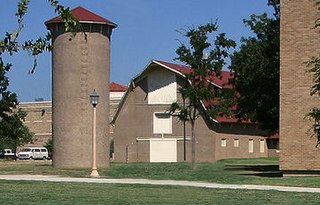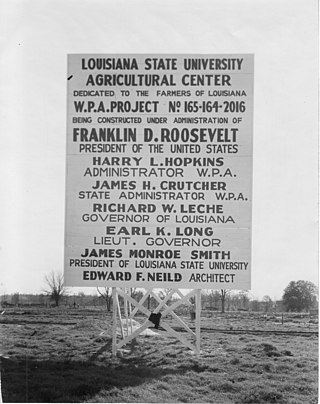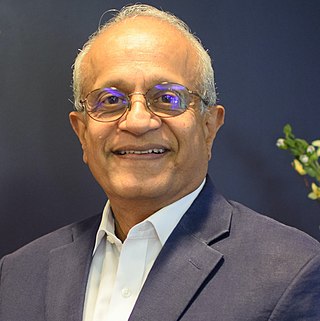
The Morrill Land-Grant Acts are United States statutes that allowed for the creation of land-grant colleges in U.S. states using the proceeds from sales of federally-owned land, often obtained from indigenous tribes through treaty, cession, or seizure. The Morrill Act of 1862 was enacted during the American Civil War, and the Morrill Act of 1890 (the Agricultural College Act of 1890 expanded this model.

The Smith–Lever Act of 1914 is a United States federal law that established a system of cooperative extension services, connected to land-grant universities, intended to inform citizens about current developments in agriculture, home economics, public policy/government, leadership, 4-H, economic development, coastal issues, and related subjects. The Act helped farmers learn new agricultural techniques by the introduction of home instruction.
The United States National Agricultural Library (NAL) is one of the world's largest agricultural research libraries, and serves as a national library of the United States and as the library of the United States Department of Agriculture. Located in Beltsville, Maryland, it is one of five national libraries of the United States. It is also the coordinator for the Agriculture Network Information Center (AgNIC), a national network of state land-grant institutions and coordinator for the U.S. Department of Agriculture (USDA) field libraries.

Agricultural education is the teaching of agriculture, natural resources, and land management. At higher levels, agricultural education is primarily undertaken to prepare students for employment in the agricultural sector. Classes taught in an agricultural education curriculum may include horticulture, land management, turf grass management, agricultural science, small animal care, machine and shop classes, health and nutrition, livestock management, and biology.

The University of Florida Institute of Food and Agricultural Sciences (UF/IFAS) is a teaching, research and Extension scientific organization focused on agriculture and natural resources. It is a partnership of federal, state, and county governments that includes an Extension office in each of Florida's 67 counties, 12 off-campus research and education centers, five demonstration units, the University of Florida College of Agricultural and Life Sciences, three 4-H camps, portions of the UF College of Veterinary Medicine, the Florida Sea Grant program, the Emerging Pathogens Institute, the UF Water Institute and the UF Genetics Institute.
The Under Secretary for Research, Education, and Economics is a high-ranking official within the United States Department of Agriculture that provides leadership and oversight for the Agricultural Research Service, National Institute of Food and Agriculture, Economic Research Service, National Agricultural Library, National Agricultural Statistics Service.

The National Institute of Food and Agriculture (NIFA) is a U.S. federal government body whose creation was mandated in the Food, Conservation, and Energy Act of 2008. Its purpose is to consolidate all federally funded agricultural research, and it is subordinate to the Department of Agriculture. It replaced the Cooperative State Research, Education, and Extension Service in 2009. As of April 11, 2022, Dionne Toombs has served as the Acting Director.
The Arkansas Agricultural Experiment Station (AAES) is the statewide research component of the University of Arkansas System's Division of Agriculture. The Division also includes the Cooperative Extension Service. The AAES and CES work together to develop and test new agricultural technology and extend it to the public. Research faculty and staff are based on five university campuses, at five Research and Extension Centers; six research stations and seven specialized units.
The University of Arkansas System Division of Agriculture is the agricultural research center for the University of Arkansas (UA).

The Louisiana State University Agricultural Center, or the LSU AgCenter, is an agriculture research center associated with the Louisiana State University System and headquartered in Baton Rouge, Louisiana. The center conducts agricultural-based research through its Louisiana Agricultural Experiment Station and extends the knowledge derived from research to the people of the state of Louisiana through its Louisiana Cooperative Extension Service. The LSU AgCenter, one of 11 institutions within the Louisiana State University System, shares physical facilities with the LSU A&M campus.
The Expanded Food and Nutrition Education Program (EFNEP) is a program of the Cooperative Extension System that operates in all 50 states and U.S. territories. Started in 1969, its purpose is to provide low-income individuals, particularly youth and families with young children, with the knowledge, skills, and desire to adopt and maintain a nutritious diet.
The Joint Subcommittee on Aquaculture (JSA), created by the National Aquaculture Act of 1980, has served as a federal interagency coordinating group to increase the overall effectiveness and productivity of federal aquaculture research, transfer, and assistance programs.
The University of Kentucky College of Agriculture is a public agricultural college at the University of Kentucky. The college was renamed the College of Agriculture, Food, and Environment on July 1, 2013. The name change incorporates the college's expanded role that occurred with the merger of the College of Human Environmental Sciences into the College of Agriculture. The college's research, teaching and outreach programs encompass farms, forests, food, fiber, families and communities.

Sonny Ramaswamy is an Indian American agricultural scientist and current President and CEO of Northwest Commission on Colleges and Universities. He formerly served as Director of the National Institute of Food and Agriculture.

University of Alaska Fairbanks Cooperative Extension Service is an outreach-based educational delivery system supported by a partnership between the United States Department of Agriculture (USDA) and the University of Alaska Fairbanks (UAF). The UAF Cooperative Extension Service annually serves approximately 80,000 Alaskans, “providing a link between Alaska's diverse people and communities by interpreting and extending relevant university, research-based knowledge in an understandable and usable form to the public.” Since 1930 the UAF Extension Service has partnered with many organizations across the state of Alaska in pursuit of fulfilling its land-grant university mission to disseminate agricultural research and other scientific information.
The Plants for Human Health Institute (PHHI) is a North Carolina State University research and education organization located at the North Carolina Research Campus in Kannapolis, North Carolina, United States. The institute researches food crops, like fruits and vegetables, and the potential health-promoting properties they may convey when consumed.
Gerald Arey Miller is an American agronomist, professor, and associate dean emeritus at Iowa State University, former director of its Agriculture and Natural Resources Extension, and former Project Director for the Heartland Regional Water Coordination Initiative in Iowa. He held the rank of Major General in the United States Army.
The National Sustainable Agriculture Coalition (NSAC) is an alliance of over 116 member groups that work collectively with NSAC's Washington, D.C.-based staff to promote and enhance sustainable food and farm policy at the federal level. NSAC aims to promote healthy rural and urban communities, support small-medium family farms, and protect natural resources. NSAC's definition of a sustainable agricultural system is one that produces readily available, affordable, nutritious food; provides farmers and laborers a high standard of living; and promotes the health of the environment and of communities.

Meryl C. Broussard, Jr. (1950–2019) was an American civil servant and executive of the United States Department of Agriculture (USDA), in the National Institute of Food and Agriculture (NIFA). He was "the first full-time national program leader for aquaculture in USDA", and he was named an "Unsung Hero" of both NIFA and USDA. In 2015 he was inducted into the NIFA Hall of Fame.










